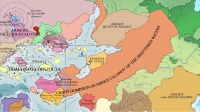Difference between revisions of "Middle Ages of Chaos"
Trismegistus (talk | contribs) m |
Trismegistus (talk | contribs) m (→See Also) |
||
| (11 intermediate revisions by the same user not shown) | |||
| Line 1: | Line 1: | ||
| − | The Middle Ages of Chaos is the period of history from circa 1800 to circa 2250 or a 450 year period. During this time in the Pallathantic, the rule of countries and tribes generally passed from the hands monarchs and manorial rulers into the hands of | + | The Middle Ages of Chaos is the period of history from circa 1800 to circa 2250 or a 450 year period. It is the second half of the greater period known as the [[Middles Ages]] (ca 1000 AI to ca 2250). During this time in the Pallathantic, the rule of countries and tribes generally passed from the hands of monarchs, archpatriarchs, and manorial rulers into the hands of immensely powerful spellcasters who relied on the power of [[chaos magic]] and [[Chaos Cults|worship]]. The [[Chaos Gods|gods]] of Chaos grew in importance with the expansion of their cults and the public acknowledgement of their powers. The period came to an end around the middle of the 23rd century with the advent of a series of well-organized and decisive assaults known as the [[Isbajutha]]. Similar campaigns were waged by the faithful Imzaami in [[Weshif]], the [[Disradún]], and northern [[Zephasia]]. |
During the 19th and 20th centuries, humans found [[Chaos Worship]] and [[Chaos Magic]] useful to fight off the hordes of humanlikes whose powers and numbers had been steadily increasing since the fall of the [[Yophenthean Empire]]. Giants, Orcs, [[Uhlak]]s, and dragons were particularly menacing in the greater Pallathantic Region. The power and influence of Chaos Magic among humans and the world came to a pitch during the dreadful [[Anarch Wars]]. | During the 19th and 20th centuries, humans found [[Chaos Worship]] and [[Chaos Magic]] useful to fight off the hordes of humanlikes whose powers and numbers had been steadily increasing since the fall of the [[Yophenthean Empire]]. Giants, Orcs, [[Uhlak]]s, and dragons were particularly menacing in the greater Pallathantic Region. The power and influence of Chaos Magic among humans and the world came to a pitch during the dreadful [[Anarch Wars]]. | ||
| + | |||
| + | Some modern scholars theorize that the [[World Soul]] underwent a fluctuation or transformation during this period which increased the power and desirability of chaos magic. | ||
| + | |||
| + | [[File:MapChaosRulersEastPallathantic.jpg|thumb|200px|Kingdom of Prince Ulcanov at its greatest extent, showing various vassals and neighboring chaos rulers' dominions]] | ||
=See Also= | =See Also= | ||
| + | *[[Age of Mage Tyrannies]] | ||
*[[Anarch Wars]] | *[[Anarch Wars]] | ||
| + | *[[Bastion of Law]] | ||
*[[Chaos Gods]] | *[[Chaos Gods]] | ||
*[[Chaos Worship]] | *[[Chaos Worship]] | ||
| Line 11: | Line 17: | ||
*[[List of Greater Chaos Rulers of the Middle Ages]] | *[[List of Greater Chaos Rulers of the Middle Ages]] | ||
*[[List of Lesser Chaos Rulers of the Middle Ages]] | *[[List of Lesser Chaos Rulers of the Middle Ages]] | ||
| + | *[[Middle Ages]] | ||
*[[Voyage of the Chaos Fleet]] | *[[Voyage of the Chaos Fleet]] | ||
| − | [[Category:Historic | + | [[Category:Historic Periods]] |
{{Chaos Rulers of the Middle Ages}} | {{Chaos Rulers of the Middle Ages}} | ||
{{stub}} | {{stub}} | ||
Latest revision as of 01:17, 17 February 2025
The Middle Ages of Chaos is the period of history from circa 1800 to circa 2250 or a 450 year period. It is the second half of the greater period known as the Middles Ages (ca 1000 AI to ca 2250). During this time in the Pallathantic, the rule of countries and tribes generally passed from the hands of monarchs, archpatriarchs, and manorial rulers into the hands of immensely powerful spellcasters who relied on the power of chaos magic and worship. The gods of Chaos grew in importance with the expansion of their cults and the public acknowledgement of their powers. The period came to an end around the middle of the 23rd century with the advent of a series of well-organized and decisive assaults known as the Isbajutha. Similar campaigns were waged by the faithful Imzaami in Weshif, the Disradún, and northern Zephasia.
During the 19th and 20th centuries, humans found Chaos Worship and Chaos Magic useful to fight off the hordes of humanlikes whose powers and numbers had been steadily increasing since the fall of the Yophenthean Empire. Giants, Orcs, Uhlaks, and dragons were particularly menacing in the greater Pallathantic Region. The power and influence of Chaos Magic among humans and the world came to a pitch during the dreadful Anarch Wars.
Some modern scholars theorize that the World Soul underwent a fluctuation or transformation during this period which increased the power and desirability of chaos magic.
See Also
- Age of Mage Tyrannies
- Anarch Wars
- Bastion of Law
- Chaos Gods
- Chaos Worship
- Isbajutha
- List of Chaos Commanders of the Middle Ages
- List of Greater Chaos Rulers of the Middle Ages
- List of Lesser Chaos Rulers of the Middle Ages
- Middle Ages
- Voyage of the Chaos Fleet
| This article is a stub. It requires further development by the creator. |
